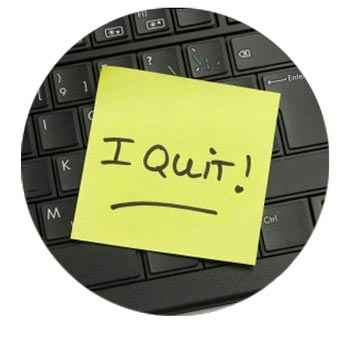IGNITE THE PASSION
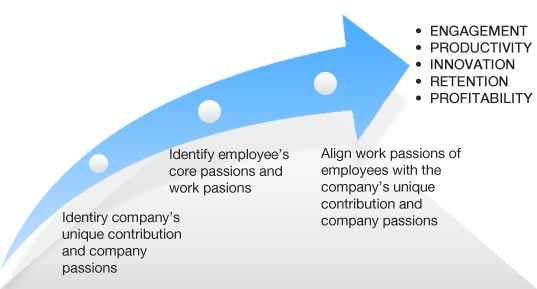
A Tool that Changes Lives:
The Passion Test® is a simple, yet powerful tool to help anyone discover the things that matter most to them in their life. Chris Attwood and Janet Bray Attwood, co-authors of the NY Times bestselling book, The Passion Test – The Effortless Path to Discovering Your Life Purpose, have helped tens of thousands of people to discover their passions and begin living their life-purpose. They have also trained over 1000 Certified Passion Test facilitators to expand their reach.
Is Now Changing Business:
Just as every individual has unique gifts and a unique purpose in life, every company provides a unique contribution to its customers, clients, and to the world. That unique contribution is the company's purpose for being.
Just as individual passions are defined by the things that matter most, a company's passions are statements of those things that matter most for the company to deliver its unique contribution, and which are expressed with an elegant simplicity that inspires passion.
By Creating Full Engagement:
The Passion Test® for Business now offers companies of any size the ability to systematically create alignment between the work passions of its employees and the mission and passions of the company. The result is a passionate, engaged workforce, made up of people who are excited about coming to work every day. That maximizes productivity, innovation, retention and bottom-line profits.
“"It's a competitive imperative. Only by loving what you do will you actually do more and do it better than the person sitting next to you."”
Larry Bossidy
Former CEO of Allied Signal and Honeywell. Author of Execution: The Art of Getting Things Done
Engagement
Many studies have proven that the major characteristic of an "engaged" employee is having passion. When they feel a strong connection or relationship and understand how they fit into the organization they are passionate about what they do. When the connection is missing or the relationships are unhealthy they feel there is no connection and therefore are not committed to or vested in the success of the organization. There is much to be said for attitude being more important than aptitude. By utilizing The Passion Test® for Business Tool, you can create a culture where you have an engaged, enthusiastic workplace which is one of the first critical steps to a successful, thriving business. The objective is to turn the statistics around; have over 80% of your people fully engaged as opposed to being not-engaged or activity disengaged.
The THREE Types of Employees
ACTIVELY ENGAGED employees
ACTIVELY ENGAGED employees work with passion and feel a profound connection to their company. They drive innovation and move the organization forward.
ENGAGED employees
ENGAGED employees are essentially "checked out." They're sleepwalking through their workday, putting time – but not energy or passion – into their work.
ACTIVELY DISENGAGED employees
ACTIVELY DISENGAGED employees aren't just unhappy at work: they're busy acting out their unhappiness. Every day, these workers undermine what their engaged coworkers accomplish.
Gallup estimates that actively disengaged employees cost their companies about $16,000 per year.
If we are generous we will say a "not engaged" employee is revenue neutral (and this is probably quite generous).
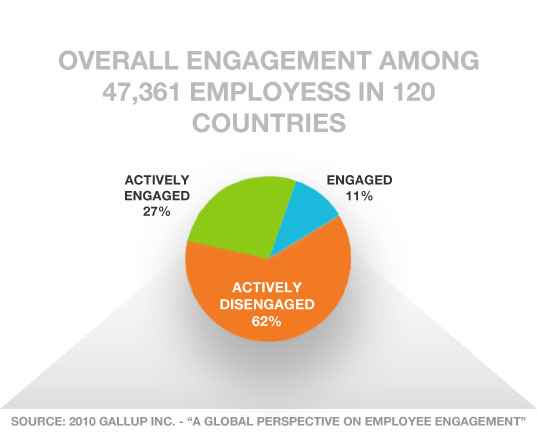
Productivity
When people are engaged, they are naturally going to be more productive – as much as 18% more productive based on recent studies. They understand the culture and vision of the organization and are focused and committed to progressing and achieving that dream. They are excellent at time-management and also recognize that it's important to recharge frequently to maintain the focus.
"The lost productivity of actively disengaged employees costs the US economy $370 BIL"
(Gallup)
Retention
"16.2% of American workers voluntarily quit their jobs in 2010."
~ U.S. Bureau of Labor StatisticsConsidering the state of the economy, these statistics are quite surprising. The costs of those workers voluntarily quitting is massive and it goes directly to the organization's bottom line. There are the labor hours that go into interviewing, rehiring; the frustrations felt by the employees filling in; lost opportunities and certainly lost talent.
Add that to the hard costs of testing, medical exams, advertising, recruiting and perhaps even the increased cost of temporary personnel and you will be shocked!
The chart below provides an idea of some of the costs associated with each new hire.
Total costs per employee per hire for this position (selected as an example) are in excess of $6,000. This comparison is based on hard costs and the time spent by the Operations Manager, Trainer, Account Executive, and the Account Manager with hourly wage rates of $75, $40, $100 and $40 respectively.
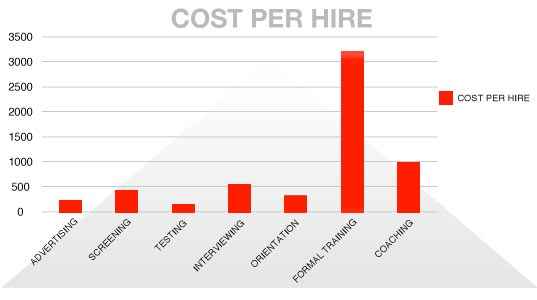
Recent studies confirm that the turnover at companies with high levels of employee engagement is 40% lower than their counterparts with low levels of engagement.
The chart below provides an idea of some of the costs associated with each new hire.
Total costs per employee per hire for this position (selected as an example) are in excess of $6,000. This comparison is based on hard costs and the time spent by the Operations Manager, Trainer, Account Executive, and the Account Manager with hourly wage rates of $75, $40, $100 and $40 respectively.

Recent studies confirm that the turnover at companies with high levels of employee engagement is 40% lower than their counterparts with low levels of engagement.
Innovation
Innovation and customer service
"Nearly 9 in 10 engaged employees (89%) strongly agreed that...
'At work, I know where to go with an idea to
improve customer service'"
~ GMJ researchers
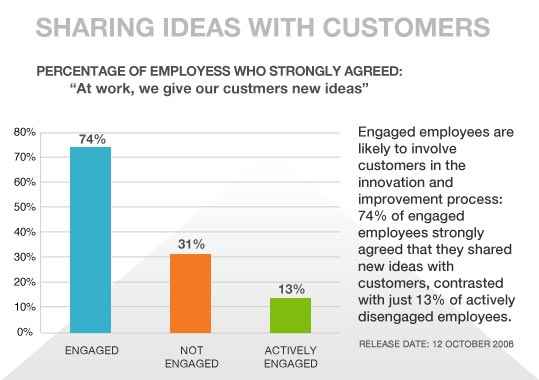
Engaged employees also involved customers in the innovation and improvement process. When asked to rate their level of agreement with the statement "At work, we give our customers new ideas," 74% of engaged employees strongly agreed that they shared new ideas with customers, contrasted with just 13% of actively disengaged employees.
Gallup's employee engagement research has consistently shown a connection between employee engagement and customer engagement. One factor that can influence customer engagement is an employee's willingness to change -- or to "learn and grow" -- to meet the customers' changing needs. When Gallup asked workers to rate the statement "I have grown in my ability to positively affect our customers," the results were telling. Almost 9 in 10 engaged employees (85%) strongly agreed that they have grown in their ability to positively affect their company's customers, while only 2 in 10 actively disengaged employees (19%) strongly agreed.
Finally, more than half of all engaged employees (51%) strongly agreed with the statement "At work, my coworkers always do what is right for our customers." This was in stark contrast to the actively disengaged employees: Only 1 in 10 strongly agreed that their coworkers always do what is right for their customers.
Profitability
"Actively disengaged employees cost U.S. businesses between
$270 billion and $343 billion every year due to low productivity."
- GallupWhat that means to you as a business owner is $16,000 per employee per year.
How Engagement Affects Financial Results Same-year operation margin: Study of 50 global companies
Towers Watson 2012 Global Workforce Study expanded on their definition of engagement to differentiate traditional engagement (which has been the buzzword for the last few years and is largely based on use of incentive-type programs) from sustainable engagement.
Sustainable engagement is that engagement that is most endurable over time. Organizations now continuing to follow the traditional engagement model are running 21st Century companies with 20th Century workplace practices and processes.
ASAP Engagement processes transform organizations in support of sustainable engagement by way of a culture change in the organization.
Source: Towers Watson normative database






